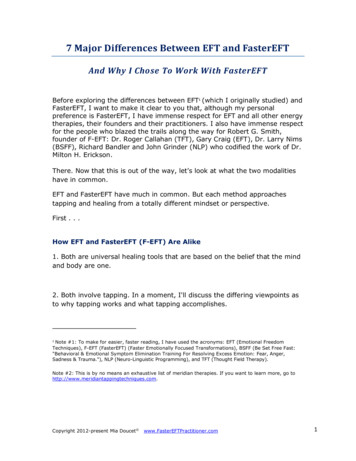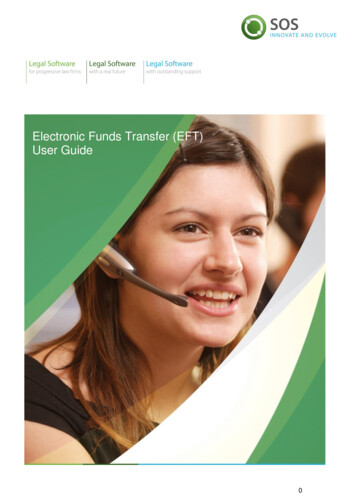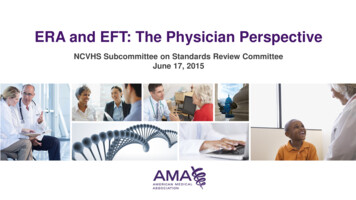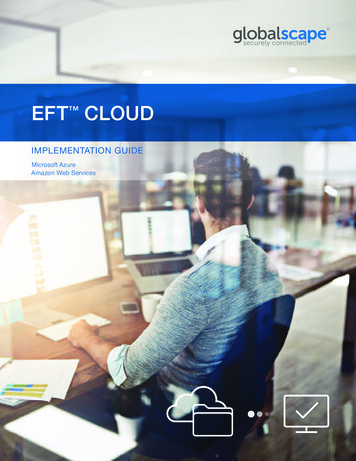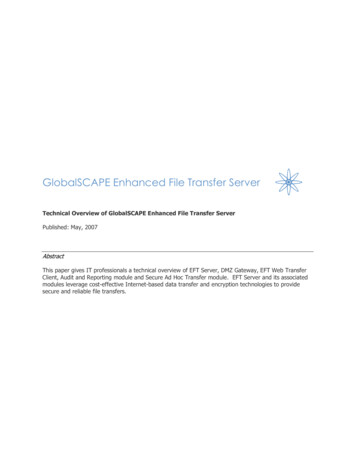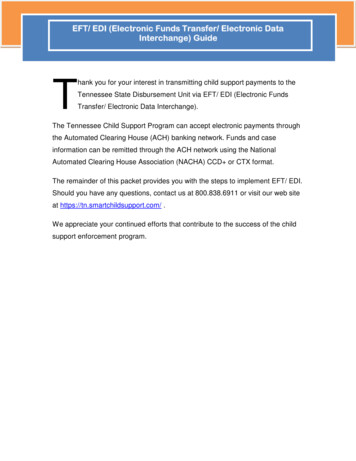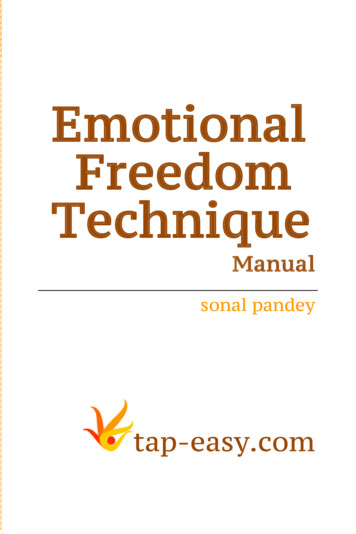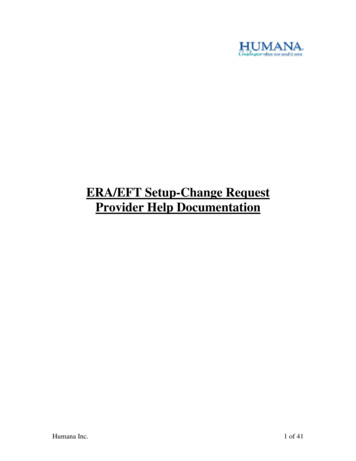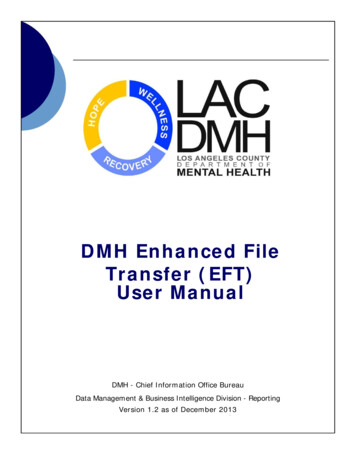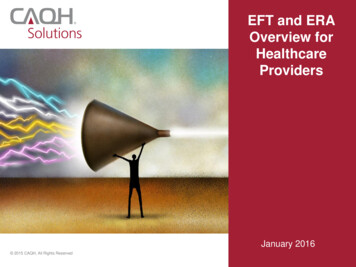
Transcription
EFT and ERAOverview forHealthcareProvidersJanuary 2016 2015 CAQH, All Rights Reserved
Overview: EFT and ERA for Healthcare ProvidersAgenda About CAQH. Explanation of EFT and ERA. Benefits for Providers using EFT and ERA. Common Myths and Misperceptions. EFT and ERA Reassociation: CAQH CORE Operating Rules Addressing Challenges of Signing up with Multiple Plans The EnrollHub Solution from CAQH. Next Steps. 2015 CAQH, All Rights Reserved2
About CAQHCAQH, a non-profit alliance, is the leader in creating shared initiatives tostreamline the business of healthcare. Through collaboration and innovation,CAQH accelerates the transformation of business processes, delivering value toproviders, patients and health plans.CAQH Initiatives: COB Smart quickly and accurately directs coordination of benefits processes. CAQH ProView eases the burden of provider data collection, maintenanceand distribution. EnrollHub reduces costly paper checks with enrollment for electronicpayments and electronic remittance advice. CAQH CORE maximizes business efficiency and savings by developing andimplementing federally mandated operating rules. CAQH Index benchmarks progress and helps optimize operations by trackingindustry adoption of electronic administrative transactions. 2015 CAQH, All Rights Reserved3
Industry Collaboration as a Key CAQH Strategy CAQH seeks to collaborate and build consensus among involvedstakeholders for lasting, effective change by:– Aligning stakeholder goals.– Creating focused direction. Health and dental plans can:– Act as catalysts for changes.– Reduce complexities of inefficient business processes.– Implement consistent approaches to non-proprietary processes. Healthcare providers can:– Promote and request consistent approaches across their vendors.– Participate in initiatives that reduce their administrative burden and costs. 2015 CAQH, All Rights Reserved4
CAQH Involvement in EFT and ERA CAQH CORE developed the ACA-mandated operating rules for EFTand ERA.– Conducts on-going outreach and education to inform health plans, providerorganizations, vendors and trading partners how to follow those rules.– Phase III CORE Certification tests compliance with the EFT/ERA operating rulesand awards certification for those entities that do so. CAQH Solutions developed an industry-wide enrollment tool toencourage easy EFT/ERA participation. CAQH Index tracks industry adoption of electronic claims paymentsand related cost savings for both plans and healthcare providers. 2015 CAQH, All Rights Reserved5
What is “Electronic Funds Transfer”? An Electronic Funds Transfer (EFT) is the electronic exchange ortransfer of funds from one account to another. EFT offers a safe, convenient, timely and less expensive alternative topaper checks or virtual card payments. In 2014, there were more than 149 million healthcare EFTtransactions from health plans to providers, transferring 876.6 billionin claim payments1. Almost all EFTs are “ACH Network” transactions.– “Automatic Clearing House” (ACH)– Form of electronic payment used by most health plans, includingMedicare, to pay healthcare providers.1. Source: NACHA, The Electronic Claims Association, October 2015 2015 CAQH, All Rights Reserved5
What is the “Automated Clearing House Network”? The ACH Network is at the center of U.S. commerce, moving moneyand information from one bank account to another through DirectDeposit and Direct Payment.– Direct deposit (e.g., employee payroll, tax refunds).– Direct payment (e.g., funds used to make a payment.) Each year it moves more than 40 trillion and nearly 23 billionelectronic financial transactions, and currently supports more than 90percent of the total value of all electronic payments in the U.S.– One of the largest, safest and most reliable payment systems in the world Instead of using paper to carry necessary transaction information,such as with checks, ACH Network transactions are transmittedelectronically, allowing for faster processing times and cost savings.Source: NACHA, The Electronic Claims Association, October 2015 2015 CAQH, All Rights Reserved6
What is Electronic Remittance Advice (ERA)? Electronic Remittance Advice (ERA) is an electronic explanation to thehealthcare provider of the health insurance payment made, including:– Information regarding the patient.– The healthcare service or procedure performed.– The healthcare provider performing that procedure.– Any claims adjustments. EFT and ERA work together, with ERA containing information about aspecific healthcare claim and resulting EFT payment. ERA used in combination with EFT enables automated reconciliation andposting. “Explanation of Benefits” (EOB) is sometimes used interchangeably withRemittance Advice, but generally refers to the claims and paymentinformation provided by paper to the provider or patient. 2015 CAQH, All Rights Reserved7
ACA-Mandated Electronic Payment Options January 1, 2014, new regulations went into effect, giving healthcareproviders the right to choose the electronic payment option (forclaims reimbursement) that is best for their practice. HIPAA requires health plans to make EFT via ACH available uponrequest. Some plans have been pro-active in their outreach to inform providersabout their EFT options. Some plans may only have a web portal or hard copy form for providersto fill out and send in to the plan for EFT enrollment. Health plans are not allowed to delay or reject an EFT or ERAtransaction and/or charge an excessive fee. However, providers should know and understand any restrictions inpayment methods when contracting with specific health plans. 2015 CAQH, All Rights Reserved8
Benefits for Providers of using EFT: Cost Savings EFT and ERA result in considerable savings1 for healthcare providers:Claim PaymentHealth Plan CostsProvider Costs(per transaction)(per transaction)Manual 0.18 4.15Electronic 0.05 1.11Savings 0.13 3.04Manual 0.17 5.36Electronic 0.04 1.19Savings 0.13 4.17Remittance Advice Additionally, on average, virtual cards charge 3% of the totaltransaction amount plus a 0.10 per transaction fee2.1. Source: 2014 CAQH Index (data from non-dental healthcare providers).2. Source: NACHA, The Electronic Claims Association. 2015 CAQH, All Rights Reserved9
Benefits for Providers of Using EFT: Improved Cash Flow Funds are received and available for use in healthcare practice bankaccounts the next business day after a plan initiates payment. Funds are available seven days faster than paper checks (onaverage).– Delays for checks includes mailing, deposit and funds clearance. No staff time required for bank visits to make deposits. 2015 CAQH, All Rights Reserved10
Why Don’t Some Providers Use EFT/ERA?A number of misperceptions prevent some healthcare practices fromusing EFT and ERA.Myth: Receiving EFT requires special equipment and a dedicated bankaccount.Fact: A healthcare practice may sign up to receive electronic payments froma health plan directly into their existing bank account. Some practices may need to upgrade their practice management oraccounting software to accommodate automated posting, but it is notnecessary if a provider simply wants to receive EFT. 2015 CAQH, All Rights Reserved11
Why Don’t Some Providers Use EFT/ERA?Myth: EFT is less secure than other methods of payment.Fact: EFT is among the safest forms of payment available. Funds aretransferred directly from the health plan bank account to the provider’sbank account via the ACH Network. EFT eliminates the risk of lost or stolen checks, or stolen virtual cardnumbers. Check fraud continues to be more prevalent than illegal access tobank accounts.1 Paper checks pass through a number of handsbefore the transaction is complete.1. Source: NACHA, The Electronic Claims Association 2015 CAQH, All Rights Reserved12
Why Don’t Some Providers Use EFT/ERA?Myth: The health plan that deposits claims payments in my account via EFTcan also remove funds as well.Fact: NACHA has in place an enforceable set of rules for all organizationsthat use the ACH Network to transmit payment.– Unauthorized debits to a provider’s account are not permitted. Per specific health plan contracts, they may seek repayment for fundssent in error (e.g., duplicate or incorrect payment).– However, this is equally true for payment methods other than EFT. 2015 CAQH, All Rights Reserved13
Why Don’t Some Providers Use EFT/ERA?Myth: It is difficult to reconcile EFT with the Remittance Advice from healthplans.Fact: Most of the leading practice management systems have the capacityto support EFT and ERA transactions. Remittance Advice is generally available via a plan web portal. Providers can work with their bank to obtain reassociation tracenumbers on EFT and ERA. 2015 CAQH, All Rights Reserved14
CAQH CORE Operating Rules Help EFT/ERA Reassociation The ACA-mandated CAQH CORE EFT & ERA Operating Rulesinclude requirements to make it easier for healthcare providers toreceive both claim payment and remittance advice electronically. The rules require health plans to transmit a trace number within theEFT so that providers can match it to a trace number in theassociation ERA. (TRM Reassociation Trace Number Data Segment). Financial institutions are required to deliver this data via a secure,electronic means.– Data is not necessarily sent automatically; a request may be required.CAQH CORE has a sample letter a provider can send to his/her bank. CAQH CORE has resources available to assist healthcare providerson this tailored website. 2015 CAQH, All Rights Reserved15
Payment Reconciliation with ERAs In most cases, ERAs can be requested at the same time as EFTs viaACH. Your bank is required to deliver ACH remittance data to yourpractice. If your bank denies this request, contact NACHA, which governs the ACHnetwork. Talk to your vendors. Communication and cooperation between allparties involved in the EFT process – practices, banks,clearinghouses, practice management systems – is essential to asmooth transition. Ask your clearinghouse and practice management system if they cansupport EFT/ERA reconciliation and auto-posting. Also, ask about anyset-up help or services they might provide. 2015 CAQH, All Rights Reserved16
Why Don’t Some Providers Use EFT/ERA?Myth: Signing up for EFT and ERA requires a complicated, time-consumingprocess with each health plan.Fact: CAQH has developed an industry-wide, multi-payer solution –EnrollHub – that enables providers to enter their banking informationonly once. This information can be then used by designated, participating healthplans to enroll and manage electronic payments and remittanceadvice. Any changes or updates to banking information is sharedautomatically with all participating plans. 2015 CAQH, All Rights Reserved17
EnrollHub One-to-Many Solution for EFT/ERAHealthcarepractice entersTIN andbankinginformationone time.Support Deskavailable to helpand shealthcarepractice toconfirm.Enrollment infosent to selectedhealth plans.Plans process provider’s enrollment and send EFT 2015 CAQH, All Rights Reserved18Plan
Easy EFT/ERA Enrollment via EnrollHub A number of national and regional health insurance plans are currentlyparticipating in EnrollHub, and new plans continue to join:– Aetna– Anthem– Cigna– Humana– Kaiser Permanente Over 200,000 healthcare providers are already participating, andthousands more join each month. 2015 CAQH, All Rights Reserved19
EnrollHub Highlights Web-based design enables providers to easily enter their EFTenrollment information. Aligns with CORE ERA / EFT Operating Rules for definition of thestandard enrollment data set and supporting documents. Provider support center addresses questions and assists withenrollments. Easy to upload documents electronically, including a voided checkor bank letter. Pre-note transactions via ACH partners to validate bank accountinformation. Health plans access enrollment information through a web-basedportal or API. CAQH works with plans to conduct campaigns to encouragegreater participation by healthcare providers. 2015 CAQH, All Rights Reserved20
EnrollHub Advantages for Healthcare Providers One-to-Many – Single, easy-to-use point of entry for providers toenroll in EFT and ERA and manage enrollment information withmultiple payers. No Cost – No charge for providers to use; participating healthplans pay a low fee to cover the costs to develop and run thesolution. Secure – Robust encryption, firewalls and strong passwordrequirements safeguard sensitive data.– Providers have complete control of their information at all times. Flexible – Focused on enrollment; enables providers to use theirpreferred downstream payment processing or remittance advicepresentment solution. 2015 CAQH, All Rights Reserved21
Next Steps: Get Started with EnrollHub Today Visit: solutions.caqh.org to register. Need assistance?– Contact the CAQH Provider Help Desk at 844-815-9763 or emailefthelp@enrollhub.caqh.org– Help Desk hours are 7am-9pm EST Monday – Thursday and 7am-7pm EST Friday 2015 CAQH, All Rights Reserved22
An Electronic Funds Transfer (EFT) is the electronic exchange or transfer of funds from one account to another. EFT offers a safe, convenient, timely and less expensive alternative to . Funds are available seven day
